
US and European satellites tracked the incoming meteor from an altitude of 65 km and obtained photos. At the same time, Sudanese villagers were eyewitness to the fireball as it experienced major ablation at an altitude between 44 and 35 km, and then underwent a catastrophic disruption at 37 km. Infrasound monitoring stations in Kenya detected airwaves equivalent to 1.1–2.1 kilotons of TNT, about one-tenth the size of the Hiroshima atomic bomb. The meteor was comparable to a PE type IIIa/b fireball, akin to a fragile cometary mass (Ceplecha et al., 1998)

Comparative size of 2008 TC3 to a person
Image from
MetaBallStudios
(https://youtu.be/bSkPNMjRRio)
Real-time IR and visual composite image of 2008 TC3 final detonation ~37 km in altitude
Image from the European Space Agency's Meteosat 8 weather satellite
(http://asima.seti.org/2008TC3/images/Meteosat8impact.jpg)
Contrail of 2008 TC3 at dawn distorted by upper atmospheric winds
Photo Credit: Mohamed Elhassan Abdelatif Mahir (Noub NGO),
Dr. Muawia H. Shaddad (Univ. Khartoum),
Dr. Peter Jenniskens (SETI Institute/NASA Ames)
Ground path of the meteoroid over Sudan
Red line is the object's path, terminating where it would have hit the ground
Green line is the infrasound detection of the explosion
Orange crosshairs mark the fireball location based on Meteosat 8 IR data
Map of Sudan: CIA Factbook. Graphic overlay: George W. Herbert, 10-07-2008
Ground path indicating the location of recovered meteorites (red dots)
Coarse-grained samples of Alamahta Sitta are only weakly shocked (S2–3) and exhibit a homogenous carbon composition with more negative δ13C values compared to fine-grained samples. The fine-grained lithology was likely formed by recrystallization of the primary coarse-grained lithology as a result of late-stage impact smelting. This process involved the degassing of lighter 12C as CO producing 13C enrichment (Storz et al., 2021 and references therein). The fine-grained lithology has significant porosity (~20%) composing a 3-D network. The olivine crystals lining the pore walls were formed by vapor deposition processes prior to re-accretion into the daughter asteroid, 2008 TC3. Mosaicism, foliation, and the presence of diamonds in fine-grained samples attest to high temperature shock metamorphism, which likely occurred during re-accretion. The occurrence of significant porosity of this meteorite led some to conclude that it was spalled from relatively unconsolidated material existing in the outer layers (shallow regolith) of the daughter asteroid. This asteroid was known through pre- and post-impact spectral data to have been an F-class asteroid in Tholen taxonomy, measuring ~4.1 m in diameter and having a long axis measuring 6.7 (±0.8) m. This is a class of asteroids located at ~2.45 AU located near the 3:1 mean motion resonance (signifying the ratio between the orbital period of Jupiter and that of an asteroid).
The presence of graphite and microdiamonds in Almahata Sitta have also been verified, but the diamond exhibits Raman spectra that are distinct from those of other brecciated and unbrecciated ureilites (Ross et al., 2010, 2011); nevertheless, the diamond lies within the spectral range of unbrecciated ureilites. The measured diamond strain values in Almahata Sitta are higher than those in other ureilites, indicating it experienced either greater shock (~6–15 GPa) or less annealing. Diamond and/or lonsdaleite formed from shocked graphite on the parent body is attested by the presence of high-pressure, compressed graphite phases. The predominance of crystalline graphite accompanying diamond leads to the conclusion that shock is likely the major cause of diamond synthesis in ureilites (Ross et al., 2011). Diamond is also considered to have formed by chemical vapor deposition (CVD) in the solar nebula, a process which may be inferred by its N-isotopic composition. In addition, single crystal diamonds measuring at least 40 µm have been identified in coarse-grained ureilite phases of Almahata Sitta, which were also likely formed by the CVD process (Miyahara et al., 2012, 2015).
Nevertheless, large diamond crystallite assemblages have been identified in a low-shock lithology from the coarse-grained ureilite AhS MS-170. These diamonds exhibit almost identical crystallographic orientation and may have originally constituted a large (~100 µm) single-crystal diamond that had been fragmented during a shock-induced graphitization process—back transformation of diamond at low-pressure and high-temperature (Nabiei et al., 2018; see image below). Evidence for this scenario exists as inclusion trails consisting of nm-scale sulfide (plus kamacite and schreibersite) grains transiting multiple diamond segments which are now cut by graphite bands (see photos below). Miyahara et al. (2015) found evidence (e.g., nitrogen sector zoning) that such large diamonds formed relatively slowly in a melt phase located deep within the UPB. Nabiei et al. (2018) argue that the Al- and Mg-free chromite inclusions present within these large diamonds attest to formation in an iron melt phase void of silicates, such as in a core or melt pod. Importantly, the sulfide + kamacite + schreibersite inclusions present within the diamonds are stable at pressures >20 GPa; such pressures would occur at the center of a Mercury-sized planet or at the core–mantle boundary of a Mars-sized planet.

Image credit: Nabiei et al., Nature Communications, vol. 9, #1327, pp. 1–9 (2018, open access link)
'A large planetary body inferred from diamond inclusions in a ureilite meteorite'
(https://doi.org/10.1038/s41467-018-03808-6)
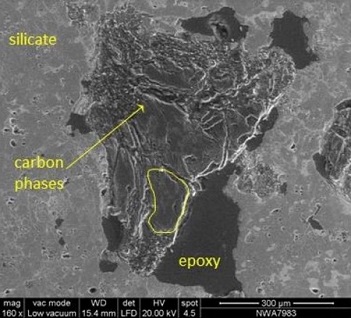
Carbon mass containing the ~100 µm-sized single diamond crystal (outlined in yellow)
Image credit: Nestola et al., PNAS, (2020, open access link)
'Impact shock origin of diamonds in ureilite meteorites'
(https://doi.org/10.1073/pnas.1919067117)
Another model which better accounts for the various thermal parameters of the ureilite parent body (UPB), as well as the accumulation of a wide variety of exotic lithologies, was developed (Goodrich et al., 2015; Wilson and Goodrich, 2016). These investigators posit that accretion of the UPB from ordinary chondrite-like precursor material occurred in the outer asteroid belt (beyond the ice line) 0.61–0.64 m.y. after CAIs. Radiogenic heating from 26Al decay led to silicate melting and melt migration to the surface, possibly aided by smelting-generated CO2. After peak temperatures were attained ~4 m.y. after CAIs, a period of slow cooling ensued, during which time gravitational perturbations from large planetary embryos (possibly aided by nebular gas drag) began to influence the UPB orbital mechanics. These forces induced a slow migration sunward over a timescale measured in millions of years, a journey which took the UPB (or possibly a second generation object) inward across the orbital paths of the OC and EC parent bodies. After the severe impact disruption of the primary UPB and re-accretion into one or more daughter bodies—an event dated at 5.4 m.y. after CAIs—the ureilite daughter body (UDB) parental to 2008 TC3 experienced substantial mass accumulation along with large-scale impact gardening. Over time, a deep loosely consolidated regolith was developed on at least a portion of the UDP surface which incorporated a wide variety of foreign impactor material, before it too experienced a disruptive event 20 m.y. ago (based on the 21Ne age of multiple clasts). Ultimately, 2008 TC3 was intercepted by Earth where the complex history of Almahata Sitta could be revealed. Furthermore, it was argued that all of the other ureilite meteorites delivered to Earth also derive from the same UDB, but the exact ejection history for each is still being determined.
Because of the lack of solar-wind-implanted gases in a sample of Almahata Sitta clasts, Bischoff et al. (2010) inferred that the meteorite could not have been derived from a regolith, and it was considered instead to represent a more deeply buried lithology (Hartmann et al., 2011). In contrast, Goodrich et al. (2015) argued that solar gases would only be implanted within the top millimeter of the regolith, and that subsequent gardening may not have accomplished homogeneous mixing into deeper regolith layers. Utilizing measurements of gamma-ray emitting radionuclides along with the calculated density range of the Almahata Sitta samples, Taricco et al. (2010) determined the shielding depth of ureilite fragment AhS 15 on asteroid 2008 TC3; activity of 60Co and 26Al indicate a shielding depth of 41 (±14) cm.
It was suggested by Goodrich et al. (2019 #2107) that the asteroid TC3 may have actually been a CC object that had incorporated ureilitic and other types of xenolithic impactors. After considering the calculated density and porosity of asteroid 2008 TC3, together with its reflectance spectra (F-class) and recovered C1 material (e.g., AhS 91/91A, AhS 202, AhS 671), Bischoff et al. (2022) also agreed that the asteroid likely had a predominant carbonaceous chondrite (C1) composition rather than ureilite composition. Furthermore, based in part on the CRE ages obtained for the individual components recovered from the Almahata Sitta fall, they were able to ascertain that accretion (or re-accretion if a daughter body) of asteroid 2008 TC3 would necessarily have occurred relatively late—possibly 50,000 to 100,000 years after CAIs. However, the lack of solar wind-implanted gases in the recovered Almahata Sitta components, including the few C1 carbonaceous samples, does not favor a scenario in which the various xenolithic impactors were incorporated into the regolith of a C1 asteroid.
Results of a trace element study of a suite of unbrecciated ureilites led Barrat et al. (2016) to propose a revised melting history for the UPB. They concluded that following the segregation of a S-rich metallic core, ureilite precursor material experienced two successive steps of melting and melt extraction. The initial extracted melts were low-density feldspathic lavas containing high abundances of Al, alkalis, and silica, comparable to some clasts identified in polymict ureilites and to two trachyandesitic lithologies identified from the Almahata Sitta fall (24.2 g MS-MU-011 [aka ALM-A] and MS-MU-035). A presumed scenario was presented in which this relatively buoyant silicic liquid was extracted, leaving behind an olivine and pigeonite residue, and ultimately reached the surface to form a crust of some extent. A representative of the next sequential melt to be extracted has not yet been identified among known meteorites, but it is inferred to have been an Al-poor, alkali-depleted liquid possibly more dense than the resulting ureilitic residues. Consequently, this melt material may have been located deeper in the mantle of the UPB where sampling would be a less likely event. Regardless of the actual density of this second-stage melt, the model scenario infers a partial melting degree of ~17–28% that was sustained throughout the entire melting event, and therefore the mass of this second-stage melt would be proportionately less than that represented by the rare trachyandesitic lithologies. The Al–Mg age determined for the ALM-A trachyandesite sample indicates that the disruption of the ureilite parent body occurred no earlier than ~6.5. m.y. after CAIs (Bischoff et al., 2014).
The ultimate parental source melt of the ureilites was enriched in incompatible trace elements relative to CI chondrites and likely contained phosphate in the form of merrillite, the latter being exhausted along with feldspar prior to the crystallization of the ureilitic residues. Based on trace element abundances and REE patterns among the ureilite samples studied, Barrat et al. (2016) resolved two distinct groups which they termed 'A' and 'B' (see more about the two groups here). The REE abundances for the ureilites constituting the smaller group B are consistent with a fractional melting model in which the critical mass porosity of the residue was zero, thereby leaving no residual melt component following extraction. However, the REE abundances for the ureilites constituting the larger group A are more consistent with a dynamic melting process in which the critical mass porosity of the residue was greater than zero (<2%), resulting in the retention of a critical fraction of melt within the residue.
The broad diversity of lithologic types present in 2008 TC3 constituted <30% of all material recovered. However, given that the vast bulk of 2008 TC3 is thought to have been lost as fine dust (≥99.9% of the estimated 42–83 ton pre-atmospheric mass), the asteroid was likely composed predominantly of very fine-grained, highly-porous, weakly-consolidated matrix material, possibly represented by the recovered specimen MS-168 and/or the C1+URE+OC+EH regolith breccia clasts AhS 91/91A and 671; this would be consistent with the reflectance spectra and other data obtained for the asteroid (Goodrich et al., 2015, 2019; Bischoff et al., 2022). Examples of some of the diverse samples that have been recovered are listed below (Bischoff et al., 2010, 2015, 2016, 2018, 2019; Horstmann and Bischoff, 2010, 2014; Hoffmann et al., 2016; Fioretti et al., 2017; Goodrich et al., 2018, 2019):
Photos courtesy of Stephan Decker–Meteorite Shop and Museum
Fitting the measured radionuclide concentrations to the known size of the pre-atmospheric asteroid for a range of estimated densities, and then utilizing the average grain density for ureilites, the total porosity of the 2008 TC3 asteroid was determined to be ~55%, consistent with its early disruption upon atmospheric entry (Welten et al., 2010). Notably, the bulk density (~1.8 g/cm³) of the asteroid was lower than that of the recovered meteorites (1.77–3.26 g/cm³). Given the density of Almahata Sitta, the pre-atmospheric size of the asteroid was calculated to have been ~4.1 m in diameter with a volume of 28 m³, and it had an oblong shape with a total mass of 51,000 kg.
In a study of oxygen isotopes for Almahata Sitta, Rumble III et al. (2010) established an oxygen three-isotope plot for a small lot of fragments. As with typical ureilites, the values are heterogeneous and plot in the upper one-third of the carbonaceous chondrite anhydrous mineral (CCAM) trend line, spanning the entire compositional range of known monomict and polymict ureilites (Rumble III et al., 2010). These data are consistent with the hypothesis that ureilites are derived from a minimally molten (20–30%) carbonaceous chondrite body, and that ureilites spanning the entire O-isotopic range constituted a common parent body. Based on its O-isotopic signature and major element chemistry, Rai et al. (2016) calculated that the precursor material for the UPB had a mixed composition consisting of CI, CM, EH, and Mg-rich chondrules.

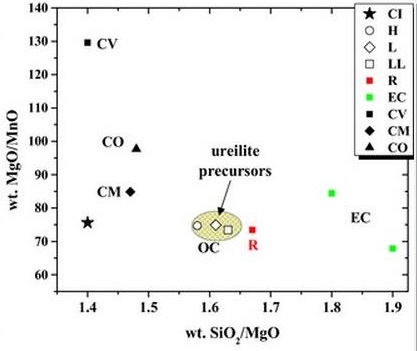



Diagram credit: Yin et al., 49th LPSC, #1810 (2018)
Oxygen Isotope Plot
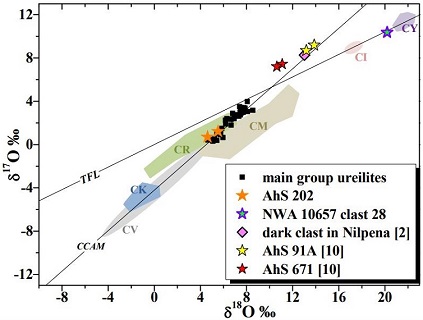
click on photo for a magnified view
Diagram credit: Goodrich et al., 50th LPSC, #1312 (2019)
An alternate model was presented by Rai et al. (2019 [#3265], 2020) to explain the observed correlation between Mg# of olivines and Δ17O as well as other properties of ureilites. The original ureilite parent body, which they termed the Proto-Ureilite Planetesimal (PUP) was initially compositionally zoned due to the difference in accretion temperatures between Mg-rich and Fe-rich nebular components; Mg-rich material condensed at higher temperatures and formed the inner portions of the PUP, while later condensing Fe-rich material formed the outer layers (see schematic illustration below). After undergoing a low-degree of partial melting and differentiation, the PUP was catastrophically disrupted and re-accreted into one or more daughter bodies comprised of a larger proportion of the Fe-rich material from the outer layers of the PUP. One such daughter body is now in a propitious location, such as near the 3:1 mean-motion resonance with Jupiter at 2.50 AU, to enable efficient delivery of fragments to Earth.
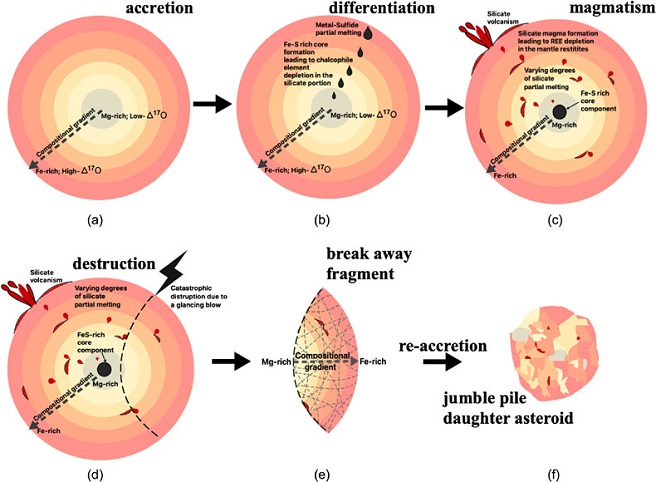
Schematic illustration credit: Rai et al., Geochemical Perspectives Letters, vol. 14, pp. 20–25 (2020, open access link)
'Ureilite meteorites provide a new model of early planetesimal formation and destruction'
(https://doi.org/10.7185/geochemlet.2018)
A classification of the Almahata Sitta polymict breccia ureilite was given by Zolensky et al. (2010). They concluded that its Mg# characterizes it as a member of Berkley's Group II, but that it falls at the extreme Mg-rich range; however, other fragments studied revealed a ferroan composition (Mikouchi et al., 2010). In the scheme of Goodrich et al. (2004), in which ureilites are divided into three distinct subgroups—olivine–pigeonite, olivine–orthopyroxene, and augite-bearing—Alamahta Sitta is a partial melt residue best described as a pigeonite-olivine ureilite due to its greater abundance of pigeonite over olivine. Unusually, due to its low Fe content, Almahata Sitta plots among the olivine-orthopyroxene subgroup. In contrast, 39 IR spectra taken from 26 stones resulted in a heterogeneous profile of silicates ranging from nearly pure olivine to nearly pure pyroxene (pigeonite), while a combined mass weighted average of all of the spectra resulted in an olivine:pyroxene ratio of 74:26, well within the range of the spectra from other ureilites (Sandford et al., 2010). The fine-grained lithology in Almahata Sitta shows evidence of reduction through impact smelting accompanied by abundant release of CO2 gas, and shock granulation of both olivine and pyroxene. This reduction process occurred at the time of the catastrophic disruption of the UPB during peak temperatures which resulted in the production of interstitial silica and tiny Fe-metal particles (Warren and Rubin, 2010); a rapid cooling phase followed.
The average CRE age based on 21Ne for four Almahata Sitta ureilite fragments was determined to be 14.5 (±0.9) m.y. (Welten et al., 2010, 2011). This age falls well within the range of typical ureilites and represents the time since asteroid 2008 TC3 broke away from its larger parent asteroid. A more reliable method employed by Welten et al. (2010) gave an average CRE age of 19.5 (±2.5) m.y., which is consistent with other ureilites. Further noble gas studies of ureilite fragments conducted by Nagao et al. (2014) gave similar 3He- and 21Ne-based CRE ages of ~20 m.y. The He-, Ne-, and Ar-based CRE age values of H and L chondrite material from Almahata Sitta were determined by Meier et al. (2010) to be ~13.6–27 m.y., overlapping within error those of Almahata Sitta ureilites. Additional noble gas studies conducted by Riebe et al. (2014) of several chondritic samples from Almahata Sitta (E, LL, CB, R-like chondrites) also support this age. With inclusion of all CRE age results obtained to date, they derived an average age of 19.7 (±2.8) m.y. This relatively young CRE age for the various components of 2008 TC3 indicates that it was located in close proximity to a mean-motion resonance. The gas retention age of the L chondrite samples from Almahata Sitta is distinct from that of the typical L group members, the latter forming an ~500 m.y. age cluster. Notably, one E chondrite sample studied by Riebe et al. (2017) designated MS-179, which is linked to the Almahata Sitta fall through multiple lines of evidence, presents a younger CRE age of 11 (±1.4) m.y. They suggest this lower CRE age might represent the actual age of the 2008 TC3 meteoroid as an independent object in space subjected to galactic cosmic rays (4π exposure), while the older ages of the other components could be attributed to pre-irradiation (2π exposure) within a regolith setting on the parent asteroid. Further noble gas data were obtained for the C1 breccia clast AhS 91A by Riebe et al. (2018 #2295), and for the trachyandesite sample MS-MU-011 Riebe et al. (2022 #6258). They found that both of these samples have similar CRE ages of ~7–8 m.y., which is significantly lower than other Almahata Sitta components measured to date. Like all other AhS samples, and consistent with its low CRE age indicating residence at some depth (at least a few meters) within a regolith, no solar-wind-implanted noble gases have yet been definitively observed in AhS 91A (Goodrich et al., 2019). Based on these CRE age data, Riebe et al. (2022) inferred that the actual length of time these fragments spent in space before arrival on Earth was no longer than ~8 m.y., with most fragments experiencing pre-irradiation before parent body breakup.
In an attempt to identify possible common ejection events among the ureilites, Beard and Swindle (2017) conducted a comparative study of 39 different samples utilizing three parameters: CRE age, Fo content in olivine (Mg#), and Δ17O value. They resolved ten potential clusters, several of which show concordance in their CRE age and Mg# but not in Δ17O value (heterogeneous), and three that are concordant in all three parameters (homogeneous). The oldest cluster they resolved, comprising DaG 084, DaG 319, Goalpara, and Haverö (homogeneous, although the Δ17O values for DaG 084 and DaG 319 have not yet been determined), reflects an ejection event that occurred 20.1 (±1.2) m.y. ago. The CRE age of this cluster is consistent with the average of all CRE age results obtained to date (see Riebe et al. [2017] information above). However, Beard and Swindle (2017) utilized alternate data for Almahata Sitta which provided a CRE age of 15.80 m.y., and they have included it along with GRA 98032 and Lahrauli within a heterogeneous cluster dated at 15.5 (±0.3) m.y. Leya and Stephenson (2019) conducted a more advanced 21Ne-based CRE age study employing 40 individual ureilites and correcting for pre-atmospheric radius and shielding depth. They determined that ureilites with short CRE ages are more highly represented than those with long CRE ages (see diagram below). This supports the inference that the ureilite parent body supplying fragments to Earth is currently moving closer to an efficient mean motion resonance.

Trapped noble gas contents and Xe-isotopic compositions in Almahata Sitta are consistent with those of other ureilites (Ott et al., 2010), with sub-µm- to several µm-sized diamonds serving as the main noble gas carrier (Murty et al., 2010). The U,Th–He ages of chondrite clasts of ~3.8 b.y. may represent the time of their incorporation into the ureilite host, which seems to correspond with the Late Heavy Bombardment period (Welten et al., 2011).
The magnetic signature of Almahata Sitta was found to be identical to that of previously studied ureilite falls, containing kamacite (two distinct phases), suessite (an iron silicide formed in situ from pre-existing ureilitic metal under low pressure [regolith], high temperature [impact heating], and very reducing conditions [abundant carbon]; Downes et al., 2010; Ross et al., 2019), schreibersite, and troilite, as well as a daubreelite-heideite phase new to ureilites which is possibly a contaminate from xenolithic clasts (Hoffmann et al., 2010). Ordinary and enstatite chondrite xenolithic clasts tend to have a much higher magnetic susceptibility. Hochleitner et al. (2010) investigated the mineralogy of Almahata Sitta and discovered up to five distinct kamacite phases. The metal phase (Kamacite I) that forms large sheets between silicate grains has a unique composition, and it was likely introduced through the impact of a Ni-poor iron meteorite. Troilite blebs located mainly in carbon-rich veins are thought to be the result of olivine reduction processes. As a result of shock re-melting processes in Almahata Sitta, grain boundary FeNi-metal particles are complex assemblages not observed in main group ureilites, comprising variable combinations of taenite, kamacite, Fe-carbide (cohenite), Fe-phosphide (schreibersite), and Fe-sulfide (Aoyagi et al., 2013). Mikouchi et al. (2014) identified an Fe-martensite phase in Almahata Sitta that is a product of very rapid quenching (>1°C/sec) at relatively low temperatures (~300–500°C). They hypothesized that the martensite was formed through an impact-related heating and fragmentation event on a small ureilitic asteroid; the asteroid probably represents a re-accreted daughter object following the collisional disruption of the original ureilite parent body.
Spectral studies of the many asteroid families have revealed some potential matches to 2008 TC3 and Almahata Sitta, especially the F-class Nysa-Polana family located in the inner Main Belt near the 3:1 resonance. The Nysa-Polana family has a low orbital inclination similar to that observed for 2008 TC3 along its trajectory to Earth (Gayon-Markt, 2011). This asteroid family contains three different types of material, including rare primitive B-type asteroids akin to ureilites, and thermally altered stony S-type and intermediate X-type asteroids. Spectrally, each of these three asteroid types have been identified in the Almahata Sitta fragments, suggesting that this mixture of asteroid types was the result of multiple low-velocity collisions. Another possible asteroid match is the Hoffmeister family located near the 5:2 resonance (Welten et al, 2010). There is also a possibility that the foreign clasts in Almahata Sitta were derived from a collision with the S-class Mildred family located in the inner Main Belt (Jenniskens et al, 2010). Asteroid 2008 TC3 is one of 69 members of the '1999TV16' association (orbital cluster) of near-Earth asteroids identified by T. J. Jopek (2020), which are predicted to generate bolides that intercept Earth during the period October 7th to February 8th (see diagram below).
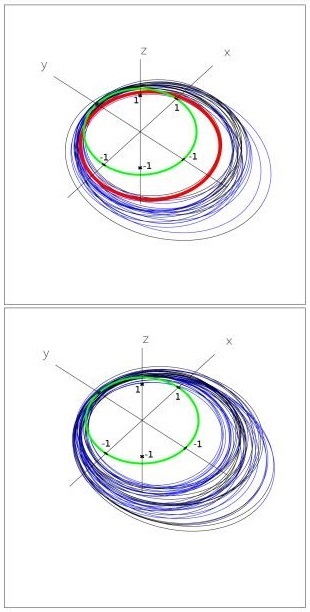

Ureilites Are Finally Figured Out